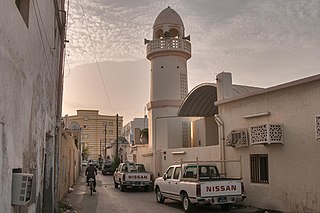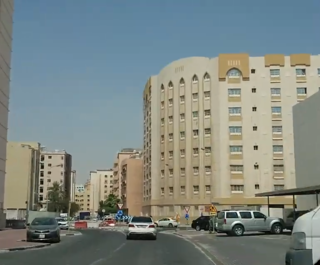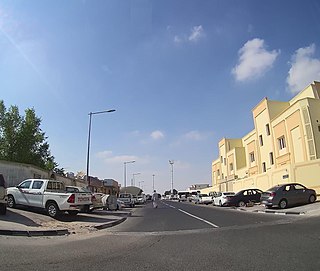
Transport in Qatar is primarily centered around the Doha Metropolitan Area (DMA), where approximately 2 million people reside and work. Doha, the capital city, serves as the national hub for government, business, and tourism, but significant development occurs outside the city as part of the government's diversification strategy.

Al Rayyan is the third-largest municipality in the state of Qatar. Its primary settlement is the city of the same name, which occupies the entire eastern section and is a part of the Doha Metropolitan Area. The vast expanse of mostly undeveloped lands in the south-west also falls under the municipality's administration.

Mesaieed is an industrial city in Al Wakrah Municipality located 36 kilometres (22 mi) south of the Qatari capital Doha. It was one of the most important cities in Qatar during the 20th century, having gained recognition as a prime industrial zone and tanking center for petroleum received from Dukhan.

Ad Dawhah al Jadidah is a district in Qatar, located in the municipality of Ad Dawhah. It is bordered to the north by Mushayrib, Fereej Al Asmakh and Barahat Al Jufairi, to the east by Old Al Ghanim, to the south by Najma and Fereej Bin Durham, and to the west by Fereej Abdel Aziz.

Old Al Ghanim is a neighborhood of the Qatari capital Doha, located in the municipality of Ad Dawhah. It forms a part of Doha's historic downtown. A notable landmark was the New World Centre, a supermarket established in 1987. It has since been relocated. Numerous other local businesses have also been relocated to other parts of Doha by the Ministry of Municipality and Environment so it could carry out massive-scale reconstruction of the neighborhood and clear out portions to make way for the Doha Metro. The Al Ghanim Central Bus station is another important landmark found here.
Since the early 2000s, Doha, the capital of Qatar has been undergoing an extensive expansion in its transportation network including the addition of new highways, the construction of a new airport, and the addition of the Doha metro. These projects are meant to keep up with the population's rapid growth, which has strained the country's current infrastructure.

Fereej Bin Mahmoud is a neighborhood of Doha, Qatar. It is one of the older multipurpose districts, with an active business scene and relatively large housing market. Located in Doha's downtown area, next to the historic district of Mushayrib, the area underwent considerable development in the 1970s. At 1.8 km2, it is a relatively large district compared to neighboring districts, and is well-connected to Doha's road network, through C Ring Road and Salwa Road. In terms of housing, apartment buildings are the dominant housing type.

Old Airport is an area of Doha, Qatar. The district is located close to the site of Doha's old international airport servicing Qatar before the construction of the Hamad International Airport. Running through the district is Al Matar Al Qadeem Street, around which many businesses and retailers cater to the residents of the area. The first mall constructed in Qatar is also located within the district, next to the congested Najma roundabout.

Rumeilah is a neighborhood of Doha, Qatar. It is divided into an eastern and western section. Zone 11, the eastern section, hosts roughly half of Al Bidda Park while Zone 21 contains most of Hamad Medical Corporation's facilities. Hamad Medical City was constructed over 227,000 square meters in Rumeilah at a cost of $659 million. Portions of Hamad Medical City form its own district to the west.

Al Waab is a district in the municipality of Al Rayyan in Qatar. The district has witnessed tremendous growth beginning in the mid-1990s, resulting in the construction of numerous residential compounds to house expatriates, villas, and commercial and medical developments. It is a district of Al Rayyan City, which, in turn, is a part of the Doha Metropolitan Area.

Al Sadd is a neighborhood of Doha, the capital city of Qatar. As one of the country's oldest surviving mixed-use districts, the neighborhood is home to hundreds of families and residences, and several malls are also found in this vast neighborhood such as the Centrepoint Mall, Lulu Centre and Royal Plaza. The football team Al-Sadd and the Al-Sadd Sports Complex are located here. Rumeilah Hospital and The Children's Hospital are also based in the district.

Mebaireek is a settlement in Qatar, located in the municipality of Al Rayyan. It was formalized as one of Al Rayyan's ten administrative zones in the mid-2000s following the merger of the two census-designated districts of Abu Nakhla and Al Mukaynis. Al Mukaynis, which is known for Mudhlem Cave, is still in Zone 81 with Mebaireek whereas Abu Nakhla has moved to Al-Shahaniya Municipality.

Duhail is a district in Qatar, located in the municipality of Doha. The district's northern half accommodates the main base of the Internal Security Forces as well as Abdullah bin Khalifa Stadium, which serves as the home grounds for Qatar Stars League club Al-Duhail SC.

Najma is a Qatari district located in the municipality of Doha. Considered to be one of Doha's older districts, the bulk of Najma's commercial and office spaces are located along the arterial roads of Airport Street, C Ring Road and B Ring Road. The district is characterized by its high population density and its historic architecture, particularly the traditional courtyard houses, some of which date back to the 1960s.

Al-Thumama is a district in Doha in Qatar. It comprises one of five mega reservoirs for Qatar, designed with the purpose of improving water security. Completed in 2020, the reservoirs are among the largest in the world in their category. The district’s Al Thumama Stadium served as one of the venues for the Qatar 2022 World Cup.

Madinat Khalifa South is a north-western district of Qatari capital Doha. It is one of the two sections of Madinat Khalifa, the other being Madinat Khalifa North. The district was constructed in the 1970s by the Emir of Qatar at the time, Sheikh Khalifa bin Hamad Al Thani, primarily to serve as a residential district for Qatari families. Shortages of affordable housing in the district have fueled illegal construction practices such as constructing additional floors.

Al Mansoura is a Qatari district in the municipality of Ad Dawhah. Together with Fereej Bin Durham, it makes up Zone 25 which has a population of 37,082.

Fereej Bin Omran is a district in Qatar, located in the municipality of Ad Dawhah. Together with New Al Hitmi and Hamad Medical City, it makes up Qatar's Zone 37, with a total population of 26,121.

Fereej Al Soudan is a district in Qatar, located in the municipality of Al Rayyan. It is mainly a residential area. In the 2015 census, it was listed as a district of Zone 55 which has a population of 283,675 and also includes Bu Sidra, Al Aziziya, Al Waab, New Fereej Al Ghanim, Muaither, Al Mearad, Fereej Al Manaseer, Fereej Al Murra and Al Sailiya. It is also listed as a district of Zone 54.

Fereej Al Murra is a district in Qatar, located in the municipality of Al Rayyan.























